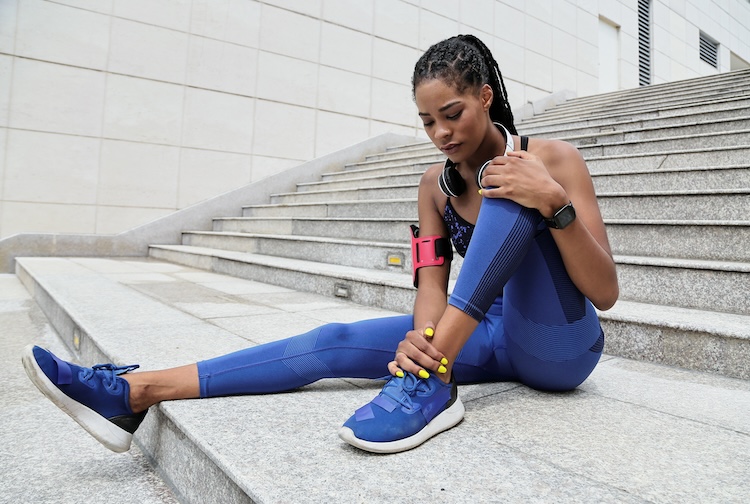
How runners can prevent injury when training or running a race
VCU Health sports medicine expert shares tips for runners to avoid injuries from training to race day.
April 18, 2024 VCU Health expert says runners tend to get more injuries when the weather gets warmer since they increase the intensity of their workouts. (Getty Images)
VCU Health expert says runners tend to get more injuries when the weather gets warmer since they increase the intensity of their workouts. (Getty Images)
By Mia Stephens
Every year, thousands of people gather in Richmond for some of the most anticipated events for running enthusiasts.
Mary Caldwell, D.O., knows the excitement of these races all too well. As an avid runner, she understands the journey from training to race day, as well as how important it is to stay healthy throughout the year.
“Every runner is different; your training and recovery needs to be tailored to you,” said Caldwell, a sports medicine doctor at VCU Health who specializes in physical medicine and rehabilitation for injuries related to running, soccer and dance, to name a few. “If something feels wrong, come get seen [by a medical professional]. It doesn't matter how silly it is, I would rather you be safe than we miss something.”
VCU Health provides medical support for several major events each year, including the Richmond Marathon, Richmond Half Marathon and the VCU Health Richmond 8K. Caldwell is serving as the medical director of VCU Health’s emergency sports medicine team for two of these races.
Caldwell spoke with VCU Health News about how runners can prevent injuries and when to seek proper care when they occur.
What are the most common injuries you have treated for your patients who are runners?
The most common injuries I have seen are patellofemoral pain syndrome also known as runner’s knee, Iliotibial band (ITB) syndrome and plantar fasciitis.
Studies show that 40% of running-related injuries come from overusing the knee, also known as runner’s knee, which is attributed to a strength deficit. Iliotibial band (ITB) syndrome happens when a band of tissue connecting the side of the knee becomes tight, caused by friction. Plantar fasciitis involves foot pain on the bottom of the foot.
All these injuries are a result of muscles sprains and strains not having the to ability calm down, which can last years if not properly treated.
Are there any injuries that are often overlooked or misdiagnosed?
Stress fractures are often missed by providers and are very serious. When a runner comes in with an injury that seems like a stress fracture, I always treat it like a stress fracture until proven otherwise. Because if you miss a stress fracture, it can be career ending for a runner.
These injuries occur when micro breaks impact the bone from being overloaded. There are four levels, or grades, to stress fractures. An injury is considered grade one if small parts of the bone break, whereas grade four involves 100% of the bone. If not treated correctly it can lead to risky complications.
Another overlooked condition is Relative Energy Deficiency Syndrome, R.E.D.-S, formerly known as Female Athlete Triad, where an energy imbalance occurs affecting functions of the body due to a lack of nutrients. Common symptoms include having bone, weight and hormonal problems.
Without enough calories, bones overcompensate for depleted nutrients which cause micro fractures. Now that we have a better understanding of RED-S we can help runners address it, which has come a long way from only being female focused.
With the changes of the seasons, how does the weather play into a runner's training or performance?
Injuries tend to be prevalent in the warmer months due to increases in intensity and neglect of proper training patterns. Running workouts should build up to no more than 10% a week in pace or endurance.
Also with warmer weather, there is an increase in heat injuries including electrolyte imbalances where potassium and sodium levels are affected, glucose irregularities and even cardiac arrest, which can become lethal. I urge runners of all levels to make sure they have clearance from a doctor to run, especially individuals with a medical history with signs of blood pressure issues, weight issues or cardiac disease.
What are some signs that runners should be aware of that might lead to injury?
If you are a new runner, I highly advise getting a physical. Physicals help to pinpoint the good and bad things to look out for to avoid a trip to the emergency room (ER).
One of the biggest signs is pain. If a runner is experiencing three out of ten levels of pain and it starts to increase, whether it is during running or after, they should get checked out. Other signs to look out for are chest pains, shortness of breath, lightheadedness.
How can someone tell that they should see their primary care provider due to an injury? At what point should they go to the emergency room instead?
If you are out on a run and you are feeling chest pains that won't stop or you’re on the verge of passing out while running, you should go to the emergency room. Especially when things feel abnormal.
For milder cases such as swelling and bruising, runners should opt to see their primary care physician.
To help prevent injuries, what are some best practices for recovery after training or a race?
Studies have shown stretching, warming up and cooling down makes minimal to no difference in someone's recovery. It is important for runners to have a well-balanced diet, get enough sleep, and stay hydrated after runs.
I encourage runners to use any electronic device, such as a Garmin or Oura ring, to track your heart rate, energy levels and sleep patterns between runs. Some apps track calories, like MyFitnessPal. All these elements track your progress and recovery through measuring body weight, exercise, and intensity of exercises.
Also consider switching up your training patterns, don't just run every day. Our bodies are meant to be dynamic, incorporate cross training into your plan to avoid injuries.
What makes VCU Health different regarding care for runners?
VCU Health has a knowledgeable team of physical therapists, sports medicine, and orthopedic surgery partners who create individualized treatment plans and help patients work up to their goals.
Our team mainly works out of the VCU Run Lab located at the Short Pump Pavilion. The lab offers a running clinic, 3D video running analysis and physical therapy to runners of all levels to help and prevent running-related injuries.
Our goal with runners is to always keep them healthy, happy, and active. We rarely see situations where a runner needs surgery because of an injury. However, anytime a runner has surgery, it can take years off their running experience, so we always strive to aim for the most conservative plan with noninvasive treatment methods.



